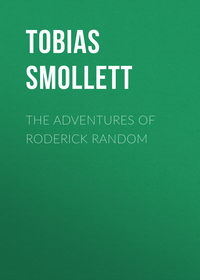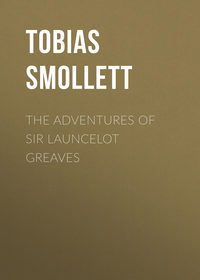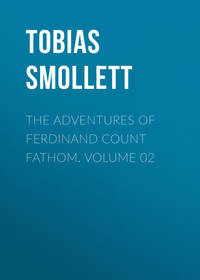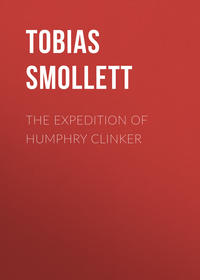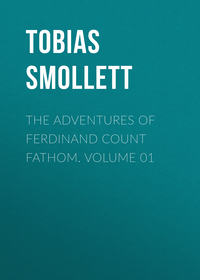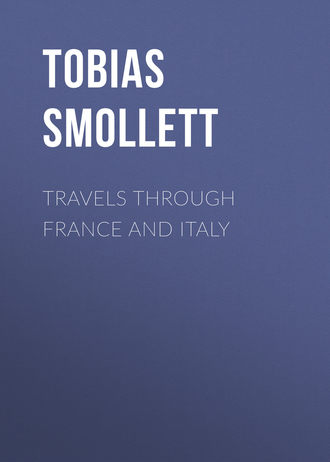 полная версия
полная версияTravels through France and Italy
At Rome he compares a presentment of St. Laurence to "a barbecued pig." "What a pity it is," he complains, "that the labours of painting should have been employed on such shocking objects of the martyrology," floggings, nailings, and unnailings… "Peter writhing on the cross, Stephen battered with stones, Sebastian stuck full of arrows, Bartholomew flayed alive," and so on. His remarks upon the famous Pieta of Michael Angelo are frank to the point of brutality. The right of sanctuary and its "infamous prerogative," unheard of in England since the days of Henry VII., were still capable of affording a lesson to the Scot abroad. "I saw a fellow who had three days before murdered his wife in the last month of pregnancy, taking the air with great composure and serenity, on the steps of a church in Florence." Smollett, it is clear, for all his philosophy, was no degenerate representative of the blind, unreasoning seventeenth-century detestation of "Popery and wooden shoes."
Smollett is one of the first to describe a "conversazione," and in illustration of the decadence of Italian manners, it is natural that he should have a good deal to tell us about the Cicisbeatura. His account of the cicisbeo and his duties, whether in Nice, Florence, or Rome, is certainly one of the most interesting that we have. Before Smollett and his almost contemporary travel correspondent, Samuel Sharp, it would probably be hard to find any mention of the cicisbeo in England, though the word was consecrated by Sheridan a few years later. Most of the "classic" accounts of the usage such as those by Mme. de Stael, Stendhal, Parini, Byron and his biographers date from very much later, when the institution was long past its prime if not actually moribund. Now Smollett saw it at the very height of its perfection and at a time when our decorous protestant curiosity on such themes was as lively as Lady Mary Montagu had found it in the case of fair Circassians and Turkish harems just thirty years previously. [A cicisbeo was a dangler. Hence the word came to be applied punningly to the bow depending from a clouded cane or ornamental crook. In sixteenth-century Spain, home of the sedan and the caballero galante, the original term was bracciere. In Venice the form was cavaliere servente. For a good note on the subject, see Sismondi's Italian Republics, ed. William Boulting, 1907, p. 793.] Like so much in the shapes and customs of Italy the cicisbeatura was in its origin partly Gothic and partly Oriental. It combined the chivalry of northern friendship with the refined passion of the South for the seclusion of women. As an experiment in protest against the insipidity which is too often an accompaniment of conjugal intercourse the institution might well seem to deserve a more tolerant and impartial investigation than it has yet received at the hands of our sociologists. A survival so picturesque could hardly be expected to outlive the bracing air of the nineteenth century. The north wind blew and by 1840 the cicisbeatura was a thing of the past.
Freed from the necessity of a systematic delineation Smollett rambles about Nice, its length and breadth, with a stone in his pouch, and wherever a cockshy is available he takes full advantage of it. He describes the ghetto (p. 171), the police arrangements of the place which he finds in the main highly efficient, and the cruel punishment of the strappado. The garrucha or strappado and the garrotes, combined with the water-torture and the rack, represented the survival of the fittest in the natural selection of torments concerning which the Holy Office in Italy and Spain had such a vast experience. The strappado as described by Smollett, however, is a more severe form of torture even than that practised by the Inquisition, and we can only hope that his description of its brutality is highly coloured. [See the extremely learned disquisition on the whole subject in Dr. H. C. Lea's History of the Inquisition in Spain, 1907, vol. iii. book vi chap. vii.] Smollett must have enjoyed himself vastly in the market at Nice. He gives an elaborate and epicurean account of his commissariat during the successive seasons of his sojourn in the neighbourhood. He was not one of these who live solely "below the diaphragm"; but he understood food well and writes about it with a catholic gusto and relish (156-165). He laments the rarity of small birds on the Riviera, and gives a highly comic account of the chasse of this species of gibier. He has a good deal to say about the sardine and tunny fishery, about the fruit and scent traffic, and about the wine industry; and he gives us a graphic sketch of the silkworm culture, which it is interesting to compare with that given by Locke in 1677. He has something to say upon the general agriculture, and more especially upon the olive and oil industry. Some remarks upon the numerous "mummeries" and festas of the inhabitants lead him into a long digression upon the feriae of the Romans. It is evident from this that the box of books which he shipped by way of Bordeaux must have been plentifully supplied with classical literature, for, as he remarks with unaffected horror, such a thing as a bookseller had not been so much as heard of in Nice. Well may he have expatiated upon the total lack of taste among the inhabitants! In dealing with the trade, revenue, and other administrative details Smollett shows himself the expert compiler and statistician a London journalist in large practice credits himself with becoming by the mere exercise of his vocation. In dealing with the patois of the country he reveals the curiosity of the trained scholar and linguist. Climate had always been one of his hobbies, and on learning that none of the local practitioners was in a position to exact a larger fee than sixpence from his patients (quantum mutatus the Nice physician of 1907!) he felt that he owed it to himself to make this the subject of an independent investigation. He kept a register of the weather during the whole of his stay, and his remarks upon the subject are still of historical interest, although with Teysseire's minutely exact Monograph on the Climatology of Nice (1881) at his disposal and innumerable commentaries thereon by specialists, the inquirer of to-day would hardly go to Smollett for his data. Then, as now, it is curious to find the rumour current that the climate of Nice was sadly deteriorating. "Nothing to what it was before the war!" as the grumbler from the South was once betrayed into saying of the August moon. Smollett's esprit chagrin was nonplussed at first to find material for complaint against a climate in which he admits that there was less rain and less wind than in any other part of the world that he knew. In these unwonted circumstances he is constrained to fall back on the hard water and the plague of cousins or gnats as affording him the legitimate grievance, in whose absence the warrior soul of the author of the Ode to Independence could never be content.
VII
For his autumn holiday in 1764 Smollett decided on a jaunt to Florence and Rome, returning to Nice for the winter; and he decided to travel as far as Leghorn by sea. There was choice between several kinds of small craft which plied along the coast, and their names recur with cheerful frequency in the pages of Marryat and other depictors of the Mediterranean. There was the felucca, an open boat with a tilt over the stern large enough to freight a post-chaise, and propelled by ten to twelve stout mariners. To commission such a boat to Genoa, a distance of a hundred miles, cost four louis. As alternative, there was the tartane, a sailing vessel with a lateen sail. Addison sailed from Marseilles to Genoa in a tartane in December 1699: a storm arose, and the patron alarmed the passengers by confessing his sins (and such sins!) loudly to a Capuchin friar who happened to be aboard. Smollett finally decided on a gondola, with four rowers and a steersman, for which he had to pay nine sequins (4 1/2 louis). After adventures off Monaco, San Remo, Noli, and elsewhere, the party are glad to make the famous phones on the Torre della Lanterna, of which banker Rogers sings in his mediocre verse:
Thy pharos Genoa first displayed itselfBurning in stillness on its rocky seat;That guiding star so oft the only one,When those now glowing in the azure vaultAre dark and silentSmollett's description of Genoa is decidedly more interesting. He arrived at a moment specially propitious to so sardonic an observer, for the Republic had fallen on evil times, having escaped from the clutches of Austria in 1746 by means of a popular riot, during which the aristocracy considerately looked the other way, only to fall into an even more embarrassed and unheroic position vis-a-vis of so diminutive an opponent as Corsica. The whole story is a curious prototype of the nineteenth century imbroglio between Spain and Cuba. Of commonplaces about the palaces fruitful of verbiage in Addison and Gray, who says with perfect truth, "I should make you sick of marble were I to tell you how it is lavished here," Smollett is sparing enough, though he evidently regards the inherited inclination of Genoese noblemen to build beyond their means as an amiable weakness. His description of the proud old Genoese nobleman, who lives in marble and feeds on scraps, is not unsympathetic, and suggests that the "deceipt of the Ligurians," which Virgil censures in the line
Haud Ligurum extremus, dum fallere fata sinebantmay possibly have been of this Balderstonian variety. But Smollett had little room in his economy for such vapouring speculations. He was as unsentimental a critic as Sydney Smith or Sir Leslie Stephen. He wants to know the assets of a place more than its associations. Facts, figures, trade and revenue returns are the data his shrewd mind requires to feed on. He has a keen eye for harbours suitable for an English frigate to lie up in, and can hardly rest until his sagacity has collected material for a political horoscope.
Smollett's remarks upon the mysterious dispensations of Providence in regard to Genoa and the retreat of the Austrians are charged to the full with his saturnine spirit. His suspicions were probably well founded. Ever since 1685 Genoa had been the more or less humiliated satellite of France, and her once famous Bank had been bled pretty extensively by both belligerents. The Senate was helpless before the Austrian engineers in 1745, and the emancipation of the city was due wholly to a popular emeute. She had relapsed again into a completely enervated condition. Smollett thought she would have been happier under British protection. But it is a vicious alternative for a nation to choose a big protector. It was characteristic of the Republic that from 1790 to 1798 its "policy" was to remain neutral. The crisis in regard to Corsica came immediately after Smollett's visit, when in 1765, under their 154th doge Francesco Maria Rovere, the Genoese offered to abandon the island to the patriots under Paoli, reserving only the possession of the two loyal coast-towns of Bonifazio and Calvi. [See Boswell's Corsica, 1766-8.] At Paoli's instance these conciliatory terms were refused. Genoa, in desperation and next door to bankruptcy, resolved to sell her rights as suzerain to France, and the compact was concluded by a treaty signed at Versailles in 1768. Paoli was finally defeated at Ponte Novo on 9th May 1769, and fled to England. On 15th August the edict of "Reunion" between France and Corsica was promulgated. On the same day Napoleon Buonaparte was born at Ajaccio.
After a week at Genoa Smollett proceeded along the coast to Lerici. There, being tired of the sea, the party disembarked, and proceeded by chaise from Sarzano to Cercio in Modenese territory, and so into Tuscany, then under the suzerainty of Austria. His description of Pisa is of an almost sunny gaiety and good humour. Italy, through this portal, was capable of casting a spell even upon a traveller so case-hardened as Smollett. The very churches at Pisa are "tolerably ornamented." The Campo Santo and Tower fall in no way short of their reputation, while the brass gates so far excel theirs that Smollett could have stood a whole day to examine and admire them. These agremens may be attributable in some measure to "a very good inn." In stating that galleys were built in the town, Smollett seems to have fallen a victim, for once, to guide-book information. Evelyn mentions that galleys were built there in his time, but that was more than a hundred years before. The slips and dock had long been abandoned, as Smollett is careful to point out in his manuscript notes, now in the British Museum. He also explains with superfluous caution that the Duomo of Pisa is not entirely Gothic. Once arrived in the capital of Tuscany, after admitting that Florence is a noble city, our traveller is anxious to avoid the hackneyed ecstasies and threadbare commonplaces, derived in those days from Vasari through Keysler and other German commentators, whose genius Smollett is inclined to discover rather "in the back than in the brain."
The two pass-words for a would-be connoisseur, according to Goldsmith, were to praise Perugino, and to say that such and such a work would have been much better had the painter devoted more time and study to it. With these alternatives at hand one might pass with credit through any famous continental collection. Smollett aspired to more independence of thought and opinion, though we perceive at every turn how completely the Protestant prejudice of his "moment" and "milieu" had obtained dominion over him. To his perception monks do not chant or intone, they bawl and bellow their litanies. Flagellants are hired peasants who pad themselves to repletion with women's bodices. The image of the Virgin Mary is bejewelled, hooped, painted, patched, curled, and frizzled in the very extremity of the fashion. No particular attention is paid by the mob to the Crucified One, but as soon as his lady-mother appeared on the shoulders of four lusty friars the whole populace fall upon their knees in the dirt. We have some characteristic criticism and observation of the Florentine nobles, the opera, the improvisatori, [For details as to the eighteenth-century improvisatore and commedia delle arte the reader is referred to Symonds's Carlo Gozzi. See also the Travel Papers of Mrs. Piozzi; Walpole's Letters to Sir Horace Mann, and Doran's Mann and Manners at the Court of Florence. (Vide Appendix A, p. 345)] the buildings, and the cicisbei. Smollett nearly always gives substantial value to his notes, however casual, for he has an historian's eye, and knows the symptoms for which the inquirer who comes after is likely to make inquisition.
Smollett's observations upon the state of Florence in Letters XXVII and XXVIII are by no means devoid of value. The direct rule of the Medici had come to an end in 1737, and Tuscany (which with the exception of the interlude of 1798-1814 remained in Austrian hands down to 1860) was in 1764 governed by the Prince de Craon, viceroy of the Empress Maria Theresa. Florence was, indeed, on the threshold of the sweeping administrative reforms instituted by Peter Leopold, the archduke for whom Smollett relates that they were preparing the Pitti Palace at the time of his stay. This Prince governed the country as Grand Duke from 1765 to 1790, when he succeeded his brother as Emperor, and left a name in history as the ill-fated Leopold. Few more active exponents of paternal reform are known to history. But the Grand Duke had to deal with a people such as Smollett describes. Conservative to the core, subservient to their religious directors, the "stupid party" in Florence proved themselves clever enough to retard the process of enlightenment by methods at which even Smollett himself might have stood amazed. The traveller touches an interesting source of biography when he refers to the Englishman called Acton, formerly an East India Company captain, now commander of the Emperor's Tuscan Navy, consisting of "a few frigates." This worthy was the old commodore whom Gibbon visited in retirement at Leghorn. The commodore was brother of Gibbon's friend, Dr. Acton, who was settled at Besancon, where his noted son, afterwards Sir John Acton, was born in 1736. Following in the footsteps of his uncle the commodore, who became a Catholic, Smollett tells us, and was promoted Admiral of Tuscany, John Acton entered the Tuscan Marine in 1775.
[Sir John Acton's subsequent career belongs to history. His origin made him an expert on naval affairs, and in 1776 he obtained some credit for an expedition which he commanded against the Barbary pirates. In 1778 Maria Carolina of Naples visited her brother Leopold at Florence, and was impressed by Acton's ugliness and reputation for exceptional efficiency. Her favourite minister, Prince Caramanico, persuaded the Grand Duke, Leopold, to permit Acton to exchange into the Neapolitan service, and reorganize the navy of the southern kingdom. This actually came to pass, and, moreover, Acton played his cards so well that he soon engrossed the ministries of War and Finance, and after the death of Caracciolo, the elder, also that of Foreign Affairs. Sir William Hamilton had a high opinion of the" General," soon to become Field-Marshal. He took a strong part in resistance to revolutionary propaganda, caused to be built the ships which assisted Nelson in 1795, and proved himself one of the most capable bureaucrats of the time. But the French proved too strong, and Napoleon was the cause of his disgrace in 1804. In that year, by special dispensation from the Pope, he married his niece, and retired to Palermo, where he died on 12th August 1811.]
Let loose in the Uffizi Gallery Smollett shocked his sensitive contemporaries by his freedom from those sham ecstasies which have too often dogged the footsteps of the virtuosi. Like Scott or Mark Twain at a later date Smollett was perfectly ready to admire anything he could understand; but he expressly disclaims pretensions to the nice discernment and delicate sensibility of the connoisseur. He would never have asked to be left alone with the Venus de Medicis as a modern art-critic is related to have asked to be left alone with the Venus of Rokeby. He would have been at a loss to understand the state of mind of the eminent actor who thought the situation demanded that he should be positively bereft of breath at first sight of the Apollo Belvedere, and panting to regain it, convulsively clutched at the arm of his companion, with difficulty articulating, "I breathe." Smollett refused to be hypnotized by the famous Venus discovered at Hadrian's villa, brought from Tivoli in 1680, and then in the height of its renown; the form he admired, but condemned the face and the posture. Personally I disagree with Smollett, though the balance of cultivated opinion has since come round to his side. The guilt of Smollett lay in criticizing what was above criticism, as the contents of the Tribuna were then held to be. And in defence of this point of view it may at least be said that the Uffizi was then, with the exception of the Vatican, the only gallery of first-rate importance open to the travelling public on the Grand Tour. Founded by Cosimo I, built originally by George Vasari, and greatly enlarged by Francis I, who succeeded to the Grand Duchy in 1574, the gallery owed most perhaps to the Cardinal, afterwards Ferdinand I, who constructed the Tribuna, and to Cardinal Leopold, an omnivorous collector, who died in 1675. But all the Medici princes added to the rarities in the various cabinets, drawing largely upon the Villa Medici at Rome for this purpose, and the last of them, John Gaston (1723-1737), was one of the most liberal as regards the freedom of access which he allowed to his accumulated treasures. Among the distinguished antiquaries who acted as curators and cicerones were Sebastiano Bianchi, Antonio Cocchi, Raymond Cocchi, Joseph Bianchi, J. B. Pelli, the Abbe Lanzi, and Zacchiroli. The last three all wrote elaborate descriptions of the Gallery during the last decades of the eighteenth century. There was unhappily an epidemic of dishonesty among the custodians of gems at this period, and, like the notorious Raspe, who fled from Cassel in 1775, and turned some of his old employers to ridicule in his Baron Munchausen, Joseph Bianchi was convicted first of robbing his cabinet and then attempting to set it on fire, for which exploit the "learned and judicious Bianchi," as Smollett called him in his first edition, was sent to prison for life. The Arrotino which Smollett so greatly admired, and which the delusive Bianchi declared to be a representation of the Augur Attus Naevius, is now described as "A Scythian whetting his knife to flay Marsyas."
Kinglake has an amusingly cynical passage on the impossibility of approaching the sacred shrines of the Holy Land in a fittingly reverential mood. Exactly the same difficulty is experienced in approaching the sacred shrines of art. Enthusiasm about great artistic productions, though we may readily understand it to be justifiable, is by no means so easily communicable. How many people possessing a real claim to culture have felt themselves puzzled by their insensibility before some great masterpiece! Conditions may be easily imagined in which the inducement to affect an ecstasy becomes so strong as to prove overpowering. Many years ago at Florence the loiterers in the Tribuna were startled by the sudden rush into the place of a little man whose literary fame gave him high claims to intuitive taste. He placed himself with high clasped hand before the chief attraction in that room of treasures. "There," he murmured, "is the Venus de Medicis, and here I must stay—for ever and for ever." He had scarcely uttered these words, each more deeply and solemnly than the preceding, when an acquaintance entered, and the enthusiast, making a hasty inquiry if Lady So-and-So had arrived, left the room not to return again that morning. Before the same statue another distinguished countryman used to pass an hour daily. His acquaintance respected his raptures and kept aloof; but a young lady, whose attention was attracted by sounds that did not seem expressive of admiration, ventured to approach, and found the poet sunk in profound, but not silent, slumber. From such absurdities as these, or of the enthusiast who went into raptures about the head of the Elgin Ilissos (which is unfortunately a headless trunk), we are happily spared in the pages of Smollett. In him complete absence of gush is accompanied by an independent judgement, for which it may quite safely be claimed that good taste is in the ascendant in the majority of cases.
From Florence Smollett set out in October 1764 for Siena, a distance of forty-two miles, in a good travelling coach; he slept there, and next day, seven and a half miles farther on, at Boon Convento, hard by Montepulciano, now justly celebrated for its wine, he had the amusing adventure with the hostler which gave occasion for his vivid portrait of an Italian uffiziale, and also to that irresistible impulse to cane the insolent hostler, from the ill consequences of which he was only saved by the underling's precipitate flight. The night was spent at Radicofani, five and twenty miles farther on. A clever postilion diversified the route to Viterbo, another forty-three miles. The party was now within sixteen leagues, or ten hours, of Rome. The road from Radicofani was notoriously bad all the way, but Smollett was too excited or too impatient to pay much attention to it. "You may guess what I felt at first sight of the city of Rome."
"When you arrive at Rome," he says later, in somewhat more accustomed vein, "you receive cards from all your country folk in that city. They expect to have the visit returned next day, when they give orders not to be at home, and you never speak to one another in the sequel. This is a refinement in hospitality and politeness which the English have invented by the strength of their own genius without any assistance either from France, Italy, or Lapland." It is needless to recapitulate Smollett's views of Rome. Every one has his own, and a passing traveller's annotations are just about as nourishing to the imagination as a bibliographer's note on the Bible. Smollett speaks in the main judiciously of the Castle of St. Angelo, the Piazza and the interior of St. Peter's, the Pincian, the Forum, the Coliseum, the Baths of Caracalla, and the other famous sights of successive ages. On Roman habits and pastimes and the gullibility of the English cognoscente he speaks with more spice of authority. Upon the whole he is decidedly modest about his virtuoso vein, and when we reflect upon the way in which standards change and idols are shifted from one pedestal to another, it seems a pity that such modesty has not more votaries. In Smollett's time we must remember that Hellenic and primitive art, whether antique or medieval, were unknown or unappreciated. The reigning models of taste in ancient sculpture were copies of fourth-century originals, Hellenistic or later productions. Hence Smollett's ecstasies over the Laocoon, the Niobe, and the Dying Gladiator. Greek art of the best period was hardly known in authentic examples; antiques so fine as the Torso of Hercules were rare. But while his failures show the danger of dogmatism in art criticism, Smollett is careful to disclaim all pretensions to the nice discernment of the real connoisseur. In cases where good sense and sincere utterance are all that is necessary he is seldom far wrong. Take the following description for example:—




